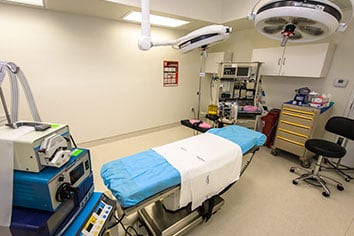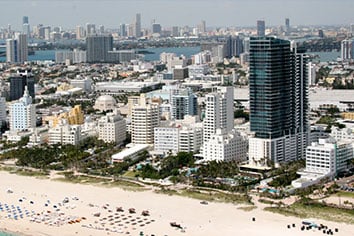Conveniently located to serve the areas of Miami and South Florida

Capsular contracture is the term given to the tightening of abnormally thickened and hard scar tissue around an existing breast implant, causing an abnormal breast profile. It is one of the most common reasons patients request cosmetic reoperation for their breasts.(1) Many women report significant distress and discomfort from capsular contracture. This condition can make the breasts appear misshapen on the chest wall. It can cause a raised, unnatural breast profile, poor nipple placement, bulging, and asymmetry. In more serious cases of capsular contracture, it may be necessary for a patient to have their implants removed or replaced in a capsulectomy procedure.
Dr. Silvia Rotemberg is a Board-Certified Cosmetic and Reconstructive Surgeon based in South Miami. She specializes in aesthetic surgical and non-surgical services for the breasts, body, and face. In her years of practice, she has treated many cases of capsular contracture, and provides effective breast implant removal and breast revision surgeries to help patients resolve this condition. If your breast implants are causing you trouble, contact us today to book a consultation with Dr. Rotemberg and find relief from the discomfort of capsular contracture. Call our offices at (305) 539-7083 or submit a simple online form with your questions and requests.
Contents
About Capsular Contracture
Patients with breast implants have their initial augmentation surgery for many reasons,which may include boosting self-esteem and body confidence. And as a result, when things go wrong after a breast augmentation procedure, the prospect of more surgery can seem daunting. However, breast tissue is affected in various ways when capsular contracture occurs, and these changes can only be addressed through medical intervention. After implants have been placed, a small number of women experience an abnormal immune response. Common symptoms of capsular contracture include:
- Firm, tight-feeling breasts
- Rippling and asymmetry of breast tissue
- Unnatural breast appearance
- Breasts that sit too high on the chest
- Excessive rounding that stretches skin
- Breast pain
- Difficulty lying on the stomach
- Scar Tissue Formation
Capsular contracture is a local fibrosis complication that occurs in the breasts following the placement of breast implants. Tissue fibrosis is the development of thick scar tissue which builds up to form a so-called “capsule” around the implant itself. Scientific studies have estimated capsular contracture rates at between 2.8% and 20.4%. (1) But what causes it and why does it occur?
In tests, capsular inflammation was significantly associated with silicone implants vs. saline implants and inflammation was significantly associated with textured implants versus smooth implants. (2) Capsular contracture is thought to be caused by a combination of multiple factors. There are a variety of theories, but scientists think it happens because of an excessive fibrotic foreign body reaction to the implant. Put simply, in these cases the body reacts and responds to the breast implants like it would other foreign bodies – it rejects them. Some theories hypothesize that an irritant, such as blood or bacteria causes immune system cells to become attracted to the area, though other risk factors have been identified, which include:
- Previous capsular fibrosis
- Radiation therapy
- Contamination with biofilm-producing bacteria
- Surgical site infections (SSI) (3)
The Baker Classification System
Doctors use the Baker System to assess the severity of capsular contracture.
- Grade I: Breasts feel soft and look natural.
- Grade II: Breasts look normal but feel firmer
- Grade III: Breast shape is abnormal and they feel firm.
- Grade IV: Breasts look abnormal, feel firm, and feel painful.
Other Iatrogenic Breast Conditions

If your breasts do not look or feel quite right, and you have undergone a breast augmentation with implants in the past, please book a consultation with Dr. Rotemberg for an expert assessment. As well as capsular contracture, there are other potentially serious complications that can occur after breast augmentation with implants.
Breast Implant Illness (BII) – Breast implant illness is an umbrella term for various symptoms such as fatigue, memory problems, chills, and chronic joint and muscle pain that many doctors now recognize as being linked to breast implants. It can affect patients with any type of implant, including silicone, saline, textured, round, or teardrop-shaped. As with cases of capsular contracture, treatment pathways for patients with BII include implant removal.
BIA-ALCL – Breast implant-associated anaplastic large cell lymphoma (BIA-ALCL) is a rare autoimmune disorder that causes chronic swelling, fluid collection around the implant (seroma), and pain. It can also lead to capsular contracture. It can remain local to the breasts, but has the potential to spread to other areas of the body via the lymphatic system. After diagnosis, a capsulectomy to remove the implant and the capsule is the standard form of treatment.
Benefits of Implant Removal & Revision
For many women, the disfigurement caused by capsular contracture is distressing. Implant removal and revision surgeries are empowering treatments that help them regain their body confidence. With implant revision or removal, patients can restore an aesthetically pleasing shape and appearance to their breast profile, and free themselves from uncomfortable and embarrassing symptoms. Addressing these issues with either total removal of breast implants or exchanging implants can significantly improve body image, and boost self-esteem.
Candidates for Capsulectomy Surgery
Not all patients with capsular contracture require further surgery. Medications such as steroids and NSAID therapy can be administered in the form of tablets, injections, or patches. (4) In cases of capsular contracture with a severity grade of I or II, continuation of non-surgical treatment is recommended. However, where non-surgical measures are insufficient, a capsulectomy is usually necessary, particularly for patients with grade III severity or higher.
Personal Consultation
All patients will see Dr. Rotemberg at a personal consultation before any surgical procedure. Your consultation will take place in a private examination room. She will listen to your concerns and take a detailed account of your symptoms and your prior medical history. She will examine your breasts and note the signs of capsular contracture. She will then discuss the treatment options available to you. Once you have established how to move forward, we will schedule the chosen procedure that will best address your condition. She will provide detailed guidelines for you to follow in the days and weeks before and after your procedure.
Capsulectomy Procedure
During surgery, Dr. Rotemberg removes the implants and the thick scarring around them. In any case, she will try to use the same surgical incision points as your previous breast surgery to limit the appearance of scarring. There are two surgical treatment pathways to correct capsular contracture.
- Composite Capsulectomy – A composite capsulectomy procedure isolates the contents of the implant and keeps the capsule intact. This reduces the risk of implant contamination.
- Subtotal Capsulectomy – Sometimes known as a partial capsulectomy, a subtotal capsulectomy removes some but not all of the capsule. As scar tissue can continue to expand and calcify (harden), there may be a greater risk of symptom recurrence.
“En Bloc”
“En bloc” is a term that is sometimes used by breast illness support groups online to describe any kind of capsulectomy. In fact, it should be stressed that en bloc capsulectomy is performed in a very limited number of cases because of the risks involved. En bloc techniques remove healthy breast tissue as well as scar tissue, so the probability of asymmetry and breast abnormality increases significantly. Therefore, this type of surgery is usually only considered for the treatment of some cases of BIA-ALCL, and not capsular contracture alone.
Recovery & Results

The aim of a corrective breast procedure is to provide relief for the patient. Dr. Rotemberg advises patients to take a few days off work to optimize their healing experience. During your recovery, you may experience some localized swelling, bruising and discomfort, but these will subside in the coming days with the use of the medications provided. You can also relieve pain with cold packs. After the swelling subsides, you will notice a new breast aesthetic and will return for a follow-up appointment to monitor your healing progress. Please bear in mind that weight loss, weight gain, pregnancy, breastfeeding, and the effects of aging may affect your results. But, with a healthy lifestyle and regular check-ups, you can live your life free from the effects of capsular contracture.
Cost of Breast Implant Removal in Miami
The cost of breast implant removal and breast implant revision for capsular contracture cases will vary from patient to patient. To discuss financing and any other queries you may have, please speak to Dr. Rotemberg at your personal consultation.
Check out Dr. Rotemberg’s blog for more information about the plastic surgery services she offers, and join us on Instagram, Facebook, and YouTube to stay in-the-know about rejuvenation procedures in South Miami.
FAQ
How do I know if I have capsular contracture?
A number of symptoms can signal capsular contracture. They include: an unnatural breast appearance, a hardening of tissue and a tightening of skin around the implants, breast pain, and rippling of the implant.
When do people start to notice capsular contracture?
Usually, patients notice capsular contracture a few months to two years after their initial breast surgery, though there are exceptions. Patients should be aware of any changes to the feeling or appearance of their breasts, and see their doctor if they notice any unusual or unexplained changes.
References
- Headon, H., Kasem, A., & Mokbel, K. (2015). Capsular Contracture after Breast Augmentation: An Update for Clinical Practice. Archives of Plastic Surgery, 42(5), 532. https://doi.org/10.5999/aps.2015.42.5.532
- Katsnelson, J. Y., Spaniol, J. R., Buinewicz, J. C., Ramsey, F. V., & Buinewicz, B. R. (2021). Outcomes of Implant Removal and Capsulectomy for Breast Implant Illness in 248 Patients. Plastic and Reconstructive Surgery Global Open, 9(9), e3813. https://doi.org/10.1097/GOX.0000000000003813
- Luvsannyam, E., Patel, D., Hassan, Z., Nukala, S., Somagutta, M. R., & Hamid, P. (2020). Overview of Risk Factors and Prevention of Capsular Contracture Following Implant-Based Breast Reconstruction and Cosmetic Surgery: A Systematic Review. Cureus. https://doi.org/10.7759/cureus.10341
- Papaconstantinou, A., Koletsa, T., Demiri, E., Gasteratos, K., Tzorakoleftheraki, S.-E., Pavlidis, L., & Spyropoulou, G.-A. (2020). Nonsurgical treatment of capsular contracture: Review of clinical studies. The Journal of International Medical Research, 48(6). https://doi.org/10.1177/0300060520927873
















